
Gobiidae or gobies is a family of bony fish in the order Gobiiformes, one of the largest fish families comprising more than 2,000 species in more than 200 genera. Most of gobiid fish are relatively small, typically less than 10 cm (3.9 in) in length, and the family includes some of the smallest vertebrates in the world, such as Trimmatom nanus and Pandaka pygmaea, Trimmatom nanus are under 1 cm long when fully grown, then Pandaka pygmaea standard length are 9 mm (0.35 in), maximum known standard length are 11 mm (0.43 in). Some large gobies can reach over 30 cm (0.98 ft) in length, but that is exceptional. Generally, they are benthic or bottom-dwellers. Although few are important as food fish for humans, they are of great significance as prey species for other commercially important fish such as cod, haddock, sea bass and flatfish. Several gobiids are also of interest as aquarium fish, such as the dartfish of the genus Ptereleotris. Phylogenetic relationships of gobiids have been studied using molecular data.

Mudskippers are any of the 23 extant species of amphibious fish from the subfamily Oxudercinae of the goby family Oxudercidae. They are known for their unusual body shapes, preferences for semiaquatic habitats, limited terrestrial locomotion and jumping, and the ability to survive prolonged periods of time both in and out of water.

The sand goby, also known as a polewig or pollybait, is a species of ray-finned fish native to marine and brackish European waters from the Baltic Sea through the Mediterranean Sea and into the Black Sea where it occurs in sandy or muddy areas of inshore waters at depths of from 4 to 200 metres. This species can reach a length of 11 centimetres (4.3 in) TL. This species is sometimes kept in public aquariums. The sand goby is of a sandy colour, with darker markings on the sides and a creamy-white underside. In the breeding season the male fish has blue spot at the rear of the first dorsal fin, ringed with white. The fish has a slender body, and the head is about a quarter of the total length.

Acentrogobius is a genus of gobies native to marine, fresh and brackish waters of the coasts of the Indian Ocean and the western Pacific Ocean.
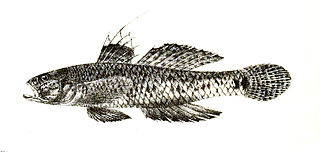
Favonigobius reichei, the Indopacific Tropical Sand Goby, is a species of goby native to fresh, brackish and marine waters of coastal areas of the Indian Ocean and the western Pacific Ocean preferring muddy or sandy substrates, often with weed growth. This species can reach a length of 8.3 centimetres (3.3 in) TL.

The Gobiiformes are an order of fish that includes the gobies and their relatives. The order, which was previously considered a suborder of Perciformes, is made up of about 2,211 species that are divided between seven families. Phylogenetic relationships of the Gobiiformes have been elucidated using molecular data. Gobiiforms are primarily small species that live in marine water, but roughly 10% of these species inhabit fresh water. This order is composed chiefly of benthic or burrowing species; like many other benthic fishes, most gobiiforms do not have a gas bladder or any other means of controlling their buoyancy in water, so they must spend most of their time on or near the bottom. Gobiiformes means "goby-like".
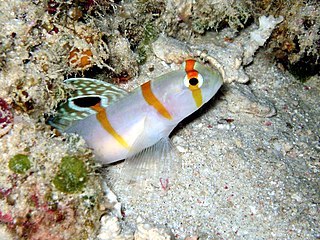
Amblyeleotris randalli, Randall's prawn goby, is a marine benthic species of goby native to tropical reefs of the central Indo-Pacific. This species can also be found in the aquarium trade.
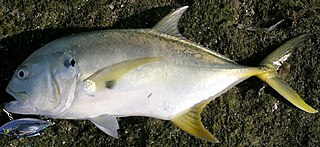
The Pacific crevalle jack is a species of large marine fish classified in the jack family Carangidae. The species is distributed through the tropical waters of the eastern Pacific Ocean from California in the north to Peru in the south, including several offshore islands. The species is best identified by its deep body and mostly unscaled breast, as well as other more detailed anatomical features. The species is known to grow to a maximum length of 101 cm and a weight of 19.7 kg. Disagreement on the status of the species has been significant in the scientific literature, with many claiming it to be conspecific with or subspecific to the Atlantic Caranx hippos. The most recent review of the crevalle jacks strongly concluded it to be a separate species based on the development of hyperostosis and fin colouring. It is predominantly a schooling inshore species, inhabiting sandy and rocky substrates, although larger individuals are occasionally found living pelagically to depths of 350 m. The Pacific crevalle jack is a fast-swimming predator, taking a variety of fish, crustaceans, and other small invertebrates. Spawning is thought to occur year-round, although peaks occur during November and May. The Pacific crevalle jack is an important species to commercial fisheries, with data available from Colima in Mexico indicating it accounts for up to 15% of the entire yearly catch. Pacific crevalle jack are highly rated gamefish, taken by both bait and a variety of lures, but are considered relatively poor quality food.

The violet goby is a species of goby native to marine, fresh and brackish waters near the Atlantic coast of North and South America from South Carolina in the United States of America, to northern Brazil. It prefers bays, estuaries and river mouths with muddy substrates. It is often marketed as the dragon goby or dragon fish.
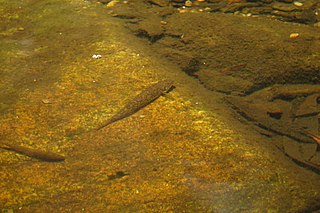
Awaous acritosus, the Roman nose goby, is a species of goby that is native to fresh water rivers and streams of Queensland, Australia and the Laloki River drainage of New Guinea.

True gobies were a subfamily, the Gobiinae, of the goby family Gobiidae, although the 5th edition of the Fishes of the World does not subdivide the Gobiidae into subfamilies. They are found in all oceans and a few rivers and lakes, but most live in warm waters. Altogether, the Gobiinae unite about 1149 described species in 160 genera, and new ones are still being discovered in numbers.

Oplopomus is a genus of gobies found in coral reefs of the Indo-Pacific region. It contains two species.

Valenciennea helsdingenii is a species of goby from the Indo-Pacific. It is commonly known as the twostripe goby, black-lined sleeper goby, or railway sleeper goby. It can grow up to a length of 25 cm (9.8 in) and is distinguishable by two prominent orange to black lines running longitudinally through its body.

Amblygobius semicinctus, the halfbarred goby , is a species of goby from family Gobiidae.

Acentrogobius cyanomos, or the threadfin blue goby is an amphidromous benthopelagic species of goby found in brackish and salt water in Bangladesh, India, Indonesia, Malaysia, and Thailand. Individuals grow up to 11.5 centimetres (4.5 in) long.
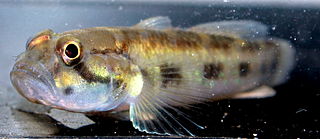
Acentrogobius viridipunctatus, or the Spotted green goby, is a species of goby found in brackish and salt water in the lower Chao Phraya River. It is the type species of the genus Acentrogobius.
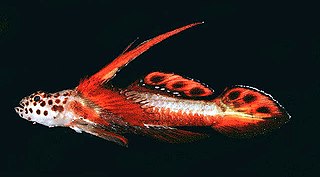
Discordipinna griessingeri is a small, brightly colored, marine neritic fish in the family Gobiidae that is commonly called the spikefin goby or flaming prawn goby. Occasionally it is mislabeled as "Stonogobiops griessingeri" which is a binomial species name that does not formally exist. The spikefin goby has a wide distribution across reefs throughout the western tropical Pacific, Pacific Islands such as Hawai'i or Polynesia, the Indian Ocean, and the Red Sea. It is also occasionally collected and traded as an exotic aquarium fish in multiple countries.
















